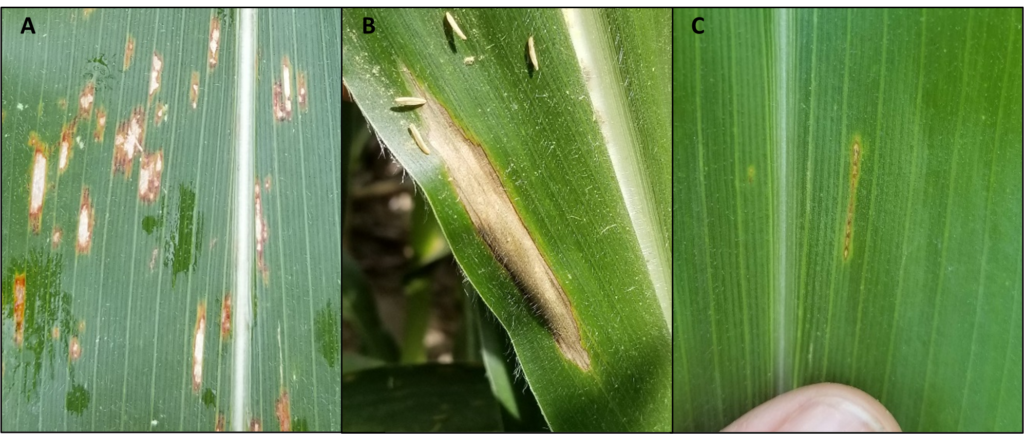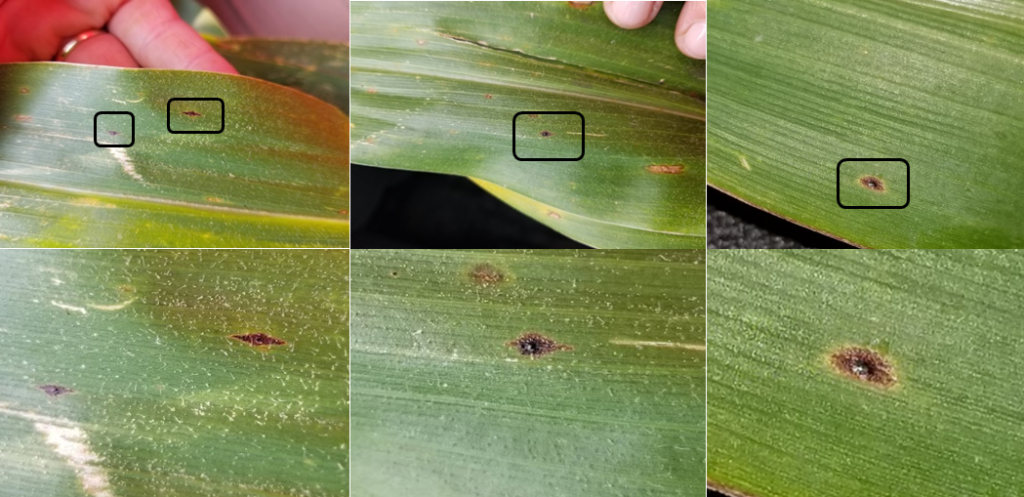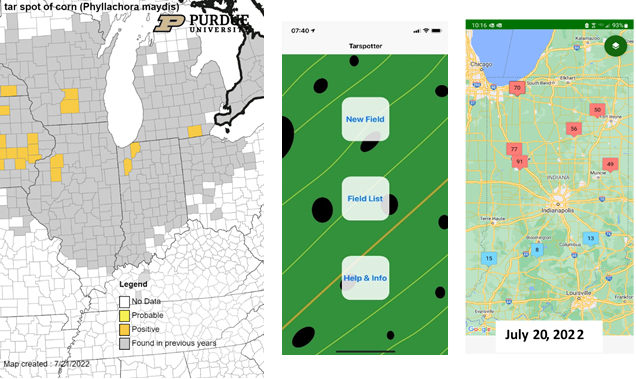Yes, we have found active tar spot in Indiana.
Corn growth stages are quite variable across Indiana but a number of areas have moved into tasseling or beyond. Therefore, it is time to continue to monitoring for diseases to make an informed decision if a fungicide is necessary. The hot and dry conditions a few weeks ago kept disease at bay, but recent rains have made conditions conducive for many of the foliar diseases in corn therefore it is now time to get out and scout. As a reminder for disease to occur, three things need to be present 1. Pathogen, 2. Host, and 3. Favorable Environment. The major diseases we monitor in Indiana such as gray leaf spot, northern corn leaf blight, northern corn leaf spot, and tar spot all might start to make an appearance (figure 1 and 2).
This week we have found a low incidence of tar spot, gray leaf spot, and common rust in the lower canopy.
A few questions to think about when scouting and looking for disease:
- What is the disease history in the field? How much residue is still present? (What happened in previous years?)
- What growth stage is the field? Early planting vs. late
- Is irrigation being applied? How much and how often? If water is being applied, it can change the environmental conditions and disease risk in a field.

Figure 1. Examples of A- gray leaf spot, B-northern corn leaf blight, and C-northern corn leaf spot lesions on a corn leaf. Photo Credits: Darcy Telenko
Tar spot of corn continues to be a concern this season after last year’s epidemic. In our scouting rounds this week and with the help of some eagle eye consultants, we have active tar spot at a low incidence in Jasper and LaPorte counties in grower fields, but have not found it in our research field trial locations. (Figure 2 and 3). Illinois, Iowa, Wisconsin, Michigan, and Georgia also have positive confirmations. The disease is just starting and the wet conditions last week probably kicked it off. Figure 2 shows how small the initial tar spot lesions (stroma) will be. In our Indiana fields, the corn was between VT and R1, had a history of tar spot. The disease was found in leaves knee to hip height in the canopy. We will continue to monitor the disease progression in these fields and will provide updates on any significant spread in the field or increases in disease severity. Again, the recent rains have favored tar spot. See the forecast from the Tarspotter App all of Indiana was red last week, whereas as of today, July 20, 2022, most of the state is still at high risk except in southern Indiana (Figure 3). If you have a history of the tar spot it is time to keep an eye out and make an informed management decision.

Figure 2. Examples of corn leaves infected by tar spot. The spots (stroma, in black squares) will be embedded in the leaf, raised (bumpy to the touch), and will not rub/wash off. In addition, they may be surround by a slight halo. Photo Credits: Darcy Telenko

Figure 3. Tar spot map for July 21, 2022 (source https://corn.ipmpipe.org/ ) and Tarspotter App forecast from July 20, 2022. Red color indicates favorable environmental conditions for tar spot if corn at V8 or older, blue color indicates unfavorable environmental conditions for tar spot. Source: Tarspotter App v. 0.53.3 Smith, D., et al. ©2022 Board of Regents of the University of Wisconsin
After hearing this news we know the next question – should I be putting out a fungicide?
Research has shown the best return on investment in making a fungicide application in corn occurs when the fungal diseases are active in the corn canopy. Most of our corn sites across the state are quite clean and disease pressure is minimal, so far this season. It is important to keep scouting, especially after last week’s rain.
A well-timed, informed fungicide application will be important to reduced disease severity when it is needed, and we recommend holding off until the diseases is active in your field and corn is at least nearing VT/R1 (tassel/silk) or even R2 (blister). Scouting will be especially important if the recent rains we have seen continue.
We are working hard to try to understand this new disease to minimize losses. The good news is that we found a number of fungicides are highly efficacious against tar spot here in Indiana when applied from tassel (VT) to R2 (milk). I would recommend picking a product with multiple modes of action. The national Corn Disease Working Group has developed a very useful fungicide efficacy table for corn diseases (see link).
Fungicide efficacy table for corn diseases: https://cropprotectionnetwork.s3.amazonaws.com/CPN2011_FungicideEfficacyControlCornDiseases_04_2022-1650470887.pdf
We will continue keeping a close eye on tar spot. I am interested in adding more locations in surrounding counties in Indiana if it is active in your field; please contact me if you suspect a field has tar spot, please or send a sample to the Purdue PPDL for confirmation. Research funding from the Indiana Corn Marketing Council is supporting sample processing, therefore there will be no charge for corn tar spot samples submitted to the clinic.
What to look for: Small, black, raised spots (circular or oval) develop on infected plants, and may appear on one or both sides of the leaves, leaf sheaths, and husks. Spots may be found on both healthy (green) and dying (brown) tissue.
I want to ask before you submit a sample you do a quick and dirty “scratch test” to see if you can rub the spot off the leaf, especially if you have leaves with just a few small spots. I have been successful in detecting these false spots by using my nail to scratch as the suspect lesion. This is a quick way to check, but as always if you are unsure send an image or the sample to the Purdue Plant Pest Diagnostic Lab. Please collect several leaves showing the symptoms and send them with a PPDL form https://ag.purdue.edu/department/btny/ppdl/submit-samples/_docs/ppdl-1-w.pdf
Please wrap the leaves in newspaper, ship in a large envelope, and ship early in the week. If you are sending samples from multiple locations, please label them and provide the date collected, hybrid if known, field zip code or county, and previous crop.
Mail to: Plant and Pest Diagnostic Laboratory, LSPS-Room 116, Purdue University, 915 W. State Street, West Lafayette, Indiana 47907-2054. The lab is operating and the building is open. If dropping off a sample is more convenient than shipping, please call or email the lab prior to stopping by Phone – 765-494-7071 or Email – ppdl-samples@purdue.edu.
In addition, the 2022 tar spot and southern rust maps are live that will be updated when a positive county confirmation is detected. If you are interested in up-to-date information on the current detection of these diseases, the maps are available on the front page of our Extension website https://extension.purdue.edu/fieldcroppathology/ or at https://corn.ipmpipe.org/
If you have any question please contact Darcy Telenko (dtelenko@purdue.edu/764-496-5168) or PPDL (ppdl-samples@purdue.edu/765-494-7071)


